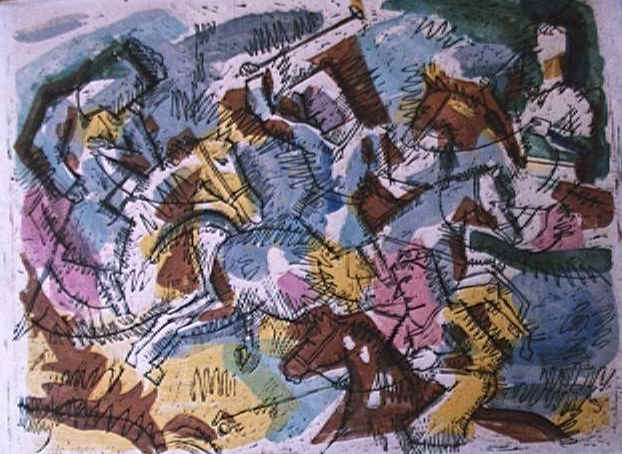
Polo, 1937
Louis Schanker was born in 1903 in the Bronx, New York. His parents were of Romanian descent and he grew up in an orthodox Jewish environment. At an early age he had an interest in both art and music. Schanker left public school at 16. He worked during the day and attended art classes in the evenings at Cooper Union. After three years he got his own apartment and began attending day classes at The Educational Alliance on New York’s Lower East Side. He also attended classes at the Art Students League. He worked in various jobs in the evenings to pay his expenses. Around 1920 he shared a studio on East Broadway with Chaim Gross, Moses, Edgar and Isaac Soyer and later Adolph Gottleib. As an Educational Alliance student his work was shown at the Anderson Gallery on 57th Street and Park Ave, He sold his first watercolor for $25. Around 1921 he left New York to work with the Sparks Circus, traveling to small cities across the country. A large man, Schanker worked with the animals, watering and cleaning the horses and elephants. For a short time he worked with the Barnum and Baily Circus and then in Minot, North Dakota he left to join a wheat threshing group of laborers which traveled across the west and up into Canada. A reoccurring theme in Schanker’s works is clowns and the circus including the murals done for the WPA in 1939. A 1930’s woodcut, “Man Threshing Wheat,” probably derives its inspiration from this period.
Schanker returned to New York and continued working during the later half of the 20’s. In 1928 a work called “landscape” attributed to “A Louis” attracted the attention of a reviewer from the New Yorker. Also in 1928 one of Schanker’s drawings of a nude was shown at the Morton Gallery and purchased by the financier, J.P. Morgan who was known to have a large collection of nudes. In 1931 a primitive portrait titled “Girl Seated in a Chair” also signed “A Louis” won a prize at a group show of over 500 entries at the Harriman Gallery in New York.
By 1931 he saved enough money (about $500,) to travel to Europe. In Paris he frequented cafes such as The Dome and Rotonde. A prix fixe meal including wine was 24 cents. When he was short money he would go to the Jewish section where his knowledge of yiddish enabled him to get soup for two cents and boiled beef for another four. He painted and went to the Louvre every day. He took a trip to Italy and then spent about a year in Spain. He lived in Mallorca, Madrid, Barcelona and Toledo. He had a show at the Bibliotheque National in Madrid.
During this trip he was most influenced by Picasso, Cezanne, Braque, Gris, and Roualt. When he returned to the United States in late 1932 he was doing semi-abstract work.
In 1933 Schanker, along with friend Hans Hoffman, was in a group show at R.H. Macys. In July of that year he had his first one-man show of semi-abstract oils at the Contemporary Arts Gallery. In 1934 he had two one-man shows one for woodcuts and a second for oils at the galleries of the New School for Social Research. In 1935 he had a one-man show at the Gallery Succession. A concurrent group show included friends Adolph Gottleib and Joseph Soloman. In 1935 his first work was accepted for the Whitney Annual Exhibition. Included among the many group shows that displayed Schanker’s works in first half of the 30’s were: Three shows at the Barbizon Plaza, American Group and two shows at the Contemporary Arts Gallery. For a time Schanker shared a teaching studio at the New School with Stanley William Hayter, another passionate experimenter, though with intaglio processes.
These were controversial times in the arts community. The Federal Government sponsored programs to assist people during the 1930’s depression when there were no jobs available. Artists were included in the Works Progress Administration Project (WPAP) and then the Workers Progress Administration (WPA) programs. Schanker participated in both beginning in 1933. He was in the mural and graphic arts departments and served as a supervisor for part of the time. In the New York City Division he worked with many other artists including Jackson Pollack, Lee Krasner, Burgoyne Diller, Byron Browne, Milton Avery, and Stuart Davis. At around the same time he and others formed a group called “The Ten [Whitney Dissenters]” which protested the lack of support for american abstract artists by the Whitney Museum. Another strong group, the American Abstract Artists, (AAA) arose to protest the lack of support of American artists by the leading museums.
Links to clippings from this period:The Ten American Abstract Artists
Home